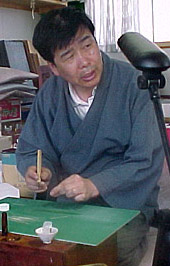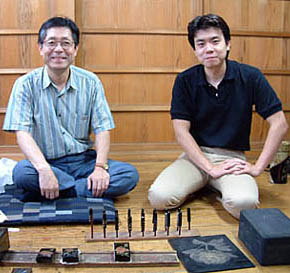|
I had just returned to my home in Tokyo after a long vacation when I discovered a week-old e-mail from Toshiya Nakata, president of Nakaya Fountain Pen Company, asking me to join him and colleagues Ms. Noritsuke and Mr. Suzuki of the Platinum Planning Division on a trip the next day to Aizu to meet maki-e artists, Hideaki Sone and Katsuhiko Terui.

Natural and colored urushi (in cups, covered with plastic wrap) with brushes |
These were the same two craftsmen who came with Platinum to demonstrate their art at the 2001 New York Pen Show.
So early the next morning, I found myself back on a bullet train speeding through the mountains of Fukushima prefecture, camera in hand (which I was requested to bring so I could write up an article about the day's events).
I was a bit surprised when I was asked to pay for my own train ticket--roughly $142.00 round trip--but I took this as an indication of the financial health of this, and probably a lot of other Japanese fountain pen companies, in this era of ballpoints and rollerballs.
After an hour and a half on the bullet train, and another hour on a local line, we arrived at Aizu-Wakamatsu station where Mr. Sone was waiting for us with his car.
Aizu-Wakamatsu is a quiet and peaceful town and is famous for its long history as a center for urushi lacquerware.
Urushi is a natural sap taken from the urushi tree, and is very expensive. Its natural color varies from a light brown to almost black. It will also cause skin poisoning if you touch it--unless you have been working with it so long that you've built up an immunity.
The process of coating a wooden object with urushi takes many steps, and the process varies according to the shape of the object. Bowls take one process called marumo while boxes with flat surfaces take a different process called itamo. The basic procedure for both of these share the following steps:
- Apply a foundation layer of urushi with a brush to cover the wood grain. This step is called kitagame.
- Apply another layer of paste made of clay powder and urushi. This step is called shitaji.
- Sand the entire surface and apply another coat of urushi.
- Sand the entire surface again and apply another coating of urushi. This step is called nakanuri.
- Lightly sand again and apply a final coat of urushi. This step is called uwa nuri.
(Between each of these steps is a hardening period of several days.)
As you can imagine with all the sanding and coating, the final product is very shiny and smooth doesn't even look like wood anymore. The color is usually a deep black or warm red. The art of urushi has been around since the Jomon period, ca. 12,000 B.C. - ca. 400 B.C. Back in an era when plastic was unheard of, such objects must have caused quite a stir.
Black or red Urushi lacquerware can be further decorated with Maki-e or some other process. Maki-e involves sprinkling gold or silver or colored powders onto the wet urushi. The maki in maki-e is the same Japanese word used for "sprinkling" or "sowing" (as in seeds). The "e" (short vowel) means "picture." So maki-e means "sprinkle pictures."
Other decorative styles include urushi-e which is painting images directly with a brush and colored urushi (mixture of colored powder and urushi), and chinkin which involves carving images into the surface of the wood and then coloring the grooves with gold foil.
In recent times, the number of maki-e craftsmen has dwindled, and the process itself has evolved. Eighty percent of the work these days is done by silk screen rather than by hand painting.

Hideaki Sone |
First we went to Mr. Sone's home where he showed us several beautiful treasures including a stunning box completely covered with gold, and decorated with flower images, and which was not for sale at any price. It had taken him and his father six months to complete.

Terui and son |
Both Mr. Sone and Mr. Terui learned the trade from their fathers who were the first two maki-e artists to be officially recognized by the Japanese government. Mr. Terui has passed the trade onto his son, Katsuhiro, while Mr. Sone has apprentices from outside the family. We asked Mr. Sone what qualities make a good apprentice, and he simply replied, "perseverence."
Mr. Sone then took us to meet Mr. Terui and his son, and the whole group headed for a locally famous soba restaurant where we talked about the local community, their craft, pens, and their trip to the New York Pen Show last year.
After lunch, we went to Mr. Sone's studio, where there were rows and rows of pen barrels and caps mounted on chopsticks. There were briar, plastic, and black hard rubber pens. While traditional urushi and maki-e has always been applied to wood, maki-e pens have expanded to include these other materials, even brass.

Pen barrels made of briar
|

Hand-painted pine bough maki-e pen
|
Mr. Sone sat down and demonstrated for us his method of hand painting a pine bough maki-e decoration on a pen. First he painted the pine needle portion with yellow colored urushi. Then, while it was still wet, we sprinkled green powder on it and dusted off the excess. He painted a few pen barrels this way and set them aside to harden. Later, he would go back and paint the branches.
Next he demonstrated a maki-e technique using fine strips of gold and abalone. First he coated the barrel with urushi which he stores in custom made tubes. This urushi was a dark brown like molasses and had a natural and rather unpleasant smell. Next, he carefully pressed the strips of gold and abalone (which he had cut earlier) one by one into the wet urushi. Then, he loaded some fine powdered gold gold into one end of a small hollow bamboo rod.
Fine silk was stretched over the opening on the other end. Then with delicate tapping, he began to sprinkle the gold dust over the still-wet urushi. Before he began this stage, he had us close the door and windows to prevent the wind from causing a disaster.
Finally he placed the pen barrel in a cabinet on a vertical wheel which automatically revolves periodically to allow even hardening without the unwanted effects of gravity. Later he would coat the entire barrel with dark urushi and then apply a technique called togidashi to once again let the abalone and gold shine through. This technique is further explained below.
After asking a few more questions of Mr. Sone and discussing current projects, and plans for a new line of Nakaya maki-e pens, we went to visit the home of Mr. Terui. He and his family live in a big traditional Japanese home, but with the loft converted into a studio. There was quite a display of maki-e and other urushi treasures including wall sized panels covered with intricate designs. There were also rows of hardening maki-e pens.
 Mr. Terui
Mr. Terui
demonstrates togidashi |
Mr. Terui and his son explained the technique of taka-maki-e which is characterized by raised images on a black urushi background. First, the image is painted onto a hardened surface of urushi. After this image has hardened, another coating of urushi is applied over the entire surface, including the image, which becomes almost obscured by the dark color of the urushi. Once this coat has hardened, the image is rubbed over with soft wet charcoal until it starts to show through again. This process is called togidashi. It is repeated several times, with the gradual building up of the painted image in several layers (with more details added each time), alternating with further coating and stripping urushi. The result is beautiful, sharp contrast--which you can both see and feel--between the raised painted images and the deep urushi background, like bright objects emerging from a dark pool.
After a bit of discussion of business matters (concerning current and future pen projects), we left the Terui household for the station to catch an evening train back to Tokyo.
I personally took back with me a new appreciation and sense of awe regarding this ancient Japanese art which has only been applied to pens in recent years. I now regard the one hand-painted maki-e pen I own as a true treasure with which I will never part.
|